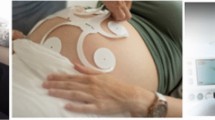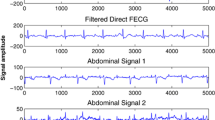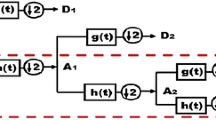Abstract
Nowadays, detecting fetal electrocardiogram (FECG) signals from a mother’s abdominal region is considered a most challenging task because of the high maternal overlapping and fetal signals at this location. Different existing FECG signal extraction techniques have been emphasized for extracting fetal ECG signal features. However, the noises present in the fetal signals still affect the overall performance; also, there is a high chance of missing waveforms and degraded signal-to-noise ratio (SNR) performance. This work proposes a novel extraction and detection technique to overcome these issues. At the initial stage, the FECG signals are collected from two datasets the abdominal and direct fetal ECG database and the Noninvasive fetal ECG database. The signals in the raw dataset with high noises are pre-processed using the twinned Savitzky-Golay filtering (Twin_SGF) model that can effectively enhance the SNR performance. After pre-processing, the FECG signals are fed into the feature extraction technique named Q-Integrated rapid-tune wavelet transform with independent component analysis (Q-IWavCA) to extract essential features from FECG signals. In addition, key characteristic information can be analyzed using the Extreme wavelet genre method (X_WavG) technique. This technique can detect P, T, QRS and ST segments effectively. The performance of a proposed method is analyzed via the MATLAB platform. The effectiveness of the proposed approach is proved by comparing it with different existing approaches in terms of sensitivity (99.3 and 99.5%), positive predictive value (PPV) (99.6 and 99.4%), F-measure (99.2 and 99.54%) are obtained for ADFECG dataset and NIFECG dataset correspondingly.





Similar content being viewed by others
Data Availability Statement
Data sharing is not applicable to this article.
References
S. Agarwal, A. Rani, V. Singh, A.P. Mittal, EEG signal enhancement using cascaded S-Golay filter. Biomed. Signal Process. Control 36, 194–204 (2017). https://doi.org/10.1016/j.bspc.2017.04.004
M. Akhavan-Amjadi, Fetal electrocardiogram modeling using hybrid evolutionary firefly algorithm and extreme learning machine. Multidimens. Syst. Signal Process. 31, 117–133 (2020). https://doi.org/10.1007/s11045-019-00653-8
Y.S. Alshebly, M. Nafea, Isolation of fetal ECG signals from abdominal ECG using wavelet analysis. IRBM 41(5), 252–260 (2020). https://doi.org/10.1016/j.irbm.2019.12.002
N. Baghel, R. Burget, M.K. Dutta, 1D-FHRNet: automatic diagnosis of fetal acidosis from fetal heart rate signals. Biomed. Signal Process. Control 71, 102794 (2022). https://doi.org/10.1016/j.bspc.2021.102794
G. Baldazzi, E. Sulas, M. Urru, R. Tumbarello, L. Raffo, D. Pani, Wavelet denoising as a post-processing enhancement method for non-invasive foetal electrocardiography. Comput. Methods Progr. Biomed. 195, 105558 (2020). https://doi.org/10.1016/j.cmpb.2020.105558
K. Barnova, R. Martinek, R. Jaros, R. Kahankova, K. Behbehani, V. Snasel, System for adaptive extraction of non-invasive fetal electrocardiogram. Appl. Soft Comput. 113, 107940 (2021). https://doi.org/10.1016/j.asoc.2021.107940
S. Cao, H. Xiao, G. Gong, W. Fang, C. Chen, Morphology extraction of fetal ECG using temporal CNN-based nonlinear adaptive noise cancelling. PLoS ONE 17(12), e0278917 (2022). https://doi.org/10.1371/journal.pone.0278917
R. Dutt, S. Mondal, A. Acharyya, Single channel blind source separation using dual extended Kalman filter, in 2021 IEEE International Symposium on Circuits and Systems (ISCAS) (2021), pp. 1–5. https://doi.org/10.1109/ISCAS51556.2021.9401796
R.Z. Ela, Prediction of ECG-biomarkers for fetal arrhythmia using non-invasive fetal ECG. Doctoral dissertation, Department of Computer Science and Engineering (CSE), Islamic University of Technology (IUT), Board Bazar, Gazipur, Bangladesh (2022)
S.E.S. Gan, S.K. Debnath, Y.S. Alshebly, H. Nugroho, S. Bagchi, M. Nafea, Fetal ECG extraction from abdominal ECG using chebyshev and butterworth filters, in 2021 IEEE Symposium on Computers and Informatics (ISCI) (2021), pp. 25–30. https://doi.org/10.1109/ISCI51925.2021.9633595
J. Hao, Y. Yang, Z. Zhou, S. Wu, Fetal electrocardiogram signal extraction based on fast independent component analysis and singular value decomposition. Sensors 22(10), 3705 (2022). https://doi.org/10.3390/s22103705
E.M. Hamzaoui, Robust blind source separation of maternal and fetal ECG signals—application to instantaneous heart rate calculation, in InInnovations in Electronics and Communication Engineering: Proceedings of the 9th ICIECE 2021 (Springer, Singapore, 2022), pp. 179–186
M.T. Haweel, O. Zahran, F.E. Abd El-Samie, Polynomial flann classifier for fetal cardiotocography monitoring, in 2021 38th National Radio Science Conference (NRSC) IEEE, vol. 1 (2021), pp. 262–270. https://doi.org/10.1109/NRSC52299.2021.9509832
G. Improta, C. Ricciardi, F. Amato, G. D’Addio, M. Cesarelli, M. Romano, Efficacy of machine learning in predicting the kind of delivery by cardiotocography, in XV Mediterranean Conference on Medical and Biological Engineering and Computing–MEDICON 2019: Proceedings of MEDICON 2019, September 26–28, 2019, Coimbra, Portugal. Springer (2020), pp. 793–799
J. Jebastine, Fetal ECG extraction and QRS detection using advanced adaptive filtering-based signal decomposition and peak threshold technique from abdominal ECG signals. Circuits, Systems, Signal Process. (2023). https://doi.org/10.1007/s00034-023-02386-3
R. Kahankova, M. Mikolasova, R. Martinek, Optimization of adaptive filter control parameters for non-invasive fetal electrocardiogram extraction. PLoS ONE 17(4), e0266807 (2022). https://doi.org/10.1371/journal.pone.0266807
A.J. Krupa, S. Dhanalakshmi, N.L. Sanjana, N. Manivannan, R. Kumar, S. Tripathy, Fetal heart rate estimation using fractional Fourier transform and wavelet analysis. Biocybern. Biomed. Eng. 41(4), 1533–1547 (2021). https://doi.org/10.1016/j.bbe.2021.09.006
H. Liu, D. Chen, G. Sun, Detection of fetal ECG R wave from single-lead abdominal ECG using a combination of RR time-series smoothing and template-matching approach. IEEE Access 7, 66633–66643 (2019). https://doi.org/10.1109/ACCESS.2019.2917826
G. Mertes, Y. Long, Z. Liu, Y. Li, Y. Yang, D.A. Clifton, A deep learning approach for the assessment of signal quality of non-invasive foetal electrocardiography. Sensors 22(9), 3303 (2022). https://doi.org/10.3390/s22093303
R.D. Mitrani, N. Dabas, J.J. Goldberger, COVID-19 cardiac injury: Implications for long-term surveillance and outcomes in survivors. Heart Rhythm 17(11), 1984–1990 (2020). https://doi.org/10.1016/j.hrthm.2020.06.026
M.R. Mohebbian, S.S. Vedaei, K.A. Wahid, A. Dinh, H.R. Marateb, K. Tavakolian, Fetal ECG extraction from maternal ECG using attention-based CycleGAN. IEEE J. Biomed. Health Inf. 26(2), 515–526 (2021). https://doi.org/10.1109/JBHI.2021.3111873
O. Rodríguez-Leor, B.C. Álvarez, S. Ojeda, J.M. Moreiras, J.R. Cuevas, R.L. Palop, A.M. Frutos, Á. Cequier, R.R. Torres, I.C. González, A.P. de Prado, Impacto de la pandemia de COVID-19 sobre la actividad asistencial en cardiología intervencionista en España. REC Intervent. Cardiol. 2(2), 82–89 (2020)
R.G. Sæderup, H. Zimmermann, D.H. Eiríksdóttir, J. Hansen, J.J. Struijk, S. Schmidt, Comparison of cardiotocography and fetal heart rate estimators based on non-invasive fetal ECG, in 2019 Computing in Cardiology (CinC) IEEE, vol. 1 (2019). https://doi.org/10.22489/CinC.2019.249
A. Subasi, S. Dogan, T. Tuncer, A novel automated tower graph based ECG signal classification method with hexadecimal local adaptive binary pattern and deep learning. J. Ambient. Intell. Hum. Comput. 14(2), 711–725 (2023). https://doi.org/10.1007/s12652-021-03324-4
M. Suganthy, S.I. Joy, P. Anandan, Detection of fetal arrhythmia by adaptive single channel electrocardiogram extraction. Phys. Eng. Sci. Med. 44(3), 683–692 (2021). https://doi.org/10.1007/s13246-021-01016-z
P. Sutha, V.E. Jayanthi, Implementation of a biopotential amplifier with a conventional and current-balancing approach for foetal ECG monitoring. Circuits Syst. Signal Process. 39, 2860–2879 (2020). https://doi.org/10.1007/s00034-019-01311-x
P. Tavoosi, F. Haghi, P. Zarjam, G. Azemi, Fetal ecg extraction from sparse representation of multi-channel abdominal recordings. Circuits, Syst., Signal Process. (2022). https://doi.org/10.1007/s00034-021-01870-y
L. Yuan, Y. Yuan, Z. Zhou, Y. Bai, S. Wu, A fetal ECG monitoring system based on the android smartphone. Sensors 19(3), 446 (2019). https://doi.org/10.3390/s19030446
Y. Zhang, A. Gu, Z. Xiao, Y. Xing, C. Yang, J. Li, C. Liu, Wearable fetal ECG monitoring system from abdominal electrocardiography recording. Biosensors 12(7), 475 (2022). https://doi.org/10.3390/bios12070475
Funding
No funding is provided for the preparation of the manuscript.
Author information
Authors and Affiliations
Contributions
All authors read and approved the final manuscript.
Corresponding author
Ethics declarations
Conflict of Interest
Authors declare that they have no conflict of interest.
Ethical Approval
This article contains no studies with human participants or animals performed by authors.
Consent to Participate
All authors have agreed to participate in this submitted article.
Consent to Publish
All the authors involved in this manuscript give full consent to publish this submitted article.
Additional information
Publisher's Note
Springer Nature remains neutral with regard to jurisdictional claims in published maps and institutional affiliations.
Rights and permissions
Springer Nature or its licensor (e.g. a society or other partner) holds exclusive rights to this article under a publishing agreement with the author(s) or other rightsholder(s); author self-archiving of the accepted manuscript version of this article is solely governed by the terms of such publishing agreement and applicable law.
About this article
Cite this article
Breesha, S.R., Vinsley, S.S. Automated Extraction of Fetal ECG Signal Features Using Twinned Filter and Integrated Methodologies. Circuits Syst Signal Process 43, 661–683 (2024). https://doi.org/10.1007/s00034-023-02494-0
Received:
Revised:
Accepted:
Published:
Issue Date:
DOI: https://doi.org/10.1007/s00034-023-02494-0




